by Andrew I Spielman
The history of professional dental publications has its roots in the medical and surgical journals that emerged almost 175 years before the first dedicated dental journal. The genesis of scientific publication dates back to 1660 when the Royal Society of London, originally known as The Royal Society of London for Improving Natural Knowledge, was founded as the first society dedicated to experimental scientific research (1).
The first issue of the Philosophical Transactions of the Royal Society of London (Fig. 1b), (2) was published on March 6, 1665, partly in response to Le Journal des Sçavans (Fig. 1a), (3), a publication by French philosophers that appeared on January 5, 1665. The Philosophical Transactions began with just 16 pages and had one issue per year, becoming the longest-running continuous periodical in English (4, 5). Similarly, Le Journal des Sçavans, despite interruptions totaling 24 years, continues to be published to this day (Fig 1a).
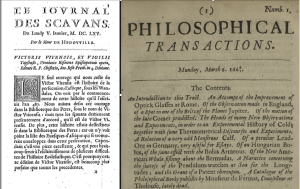
Figure 1a. The first issue of Le Journal des Sçavans. 1b. The first issue of the Philosophical Transactions of the Royal Society of London.
A critical milestone in scientific publications was the introduction of the peer-review system in 1733 by “The Edinburgh Medical Journal (6).” The editor’s introduction outlined that the peer-review process was intended to encourage other authors to submit their work and build trust in scientific data:
“One probable method of remedying these two discouragements to learning (..time and inclination to compose sizeable treatise.. ed. note) is to publish collections of small treatises, submitted to the examination of a Society of such who had particularly studied the science which is the subject of each tract; and who should give some short account of the most remarkable and useful discoveries’ and improvements made by the contemporary authors in their own profession. (Fig. 2) (7).

Figure 2. The first peer-review system explained in the Preface of The Edinburgh Medical Journal (7).
As dentistry emerged as an independent profession in 18th-century France, largely thanks to Pierre Fauchard, the need to disseminate knowledge became increasingly vital. However, without a dedicated dental journal, authors resorted to publishing either books or shorter articles in medical and surgical journals. A notable example was Julien Botot, physician to King Louis XV, who published an article on periodontal disease in the “Journal de Medicine, Chirurgie, Pharmacie” in 1770 (Fig. 3). Another notable example of orofacial cases in medical journals is found in “The Medical and Philosophical Commentaries of the Society of Physicians in Edinburgh,” where a 1774 report described a case of a locked jaw leading to a patient’s death. Despite treatments like bathing, bleeding, fumigations, emollient cataplasms, embrocations, and laudanum (8), state-of-the-art treatment for its time, the patient died from the condition’s complications. The report’s author, Dr. Manget, a Geneva-based physician, noted that he had successfully treated a similar case using “mercurial friction.”
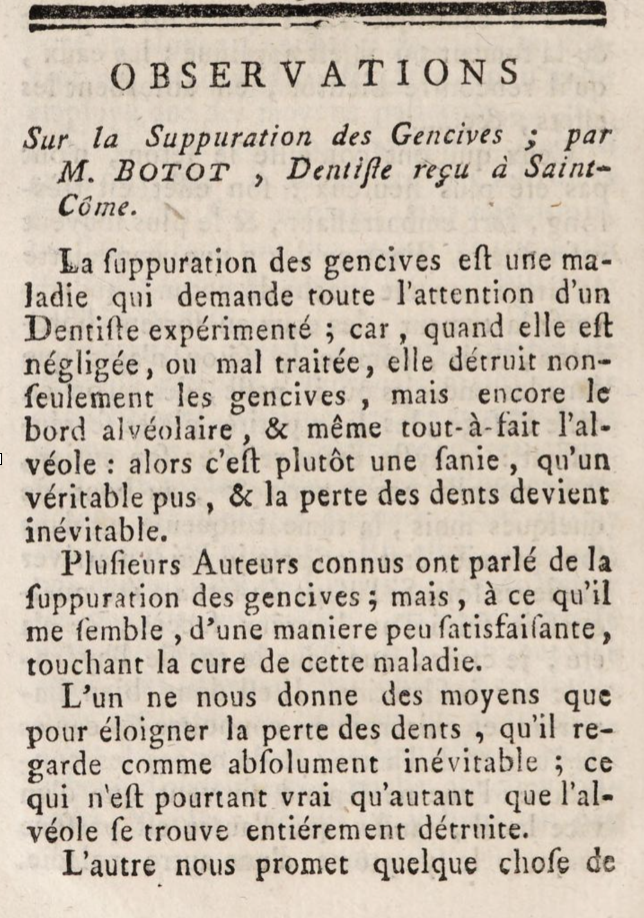
Figure 3. An article on periodontal disease authored by Julien Botot, physician to King Louis XV.
The inaugural issue of the French journal “Journal de Chirurgie” (1791) documented cases of mandibular trauma, maxillary sinus fungus, mandibular necrosis following an infected wisdom tooth, and the surgical correction of a bilateral cleft lip (Fig. 4) (9). While some journals focused on original research, others, like the German “Medizinisch-Chirurgische Zeitung” published in 1790 in Salzburg, primarily provided reviews of German, French, and English medical and surgical texts and translations of previously published works, including John Hunter’s 1786 A Treatise on the Venereal Disease (10).

Figure 4. Surgical correction of a bilateral cleft lip published in the inaugural issue of Journal de Chirurgie, 1791 (9).
Dental-specific scientific journals only emerged in the third decade of the 19th century. In 1839, “The American Journal of Dental Science” (AJDS) was established as the first dedicated dental journal. Its principal promoters were Solyman Brown, Eleazar Parmly, Horace Hayden, Chapin Harris, Woodruff Brown, and Elisha Baker, prominent New York and Baltimore dentists, leading educators and proponents of reform in dentistry. Within a year, the journal had 174 subscribers from 22 US states and international readers from England, France, Holland, and the West Indies. It was renamed The American Journal and Library of Dental Science after the second issue. The circulation after four issues reached over 500, a significant number for the period. It was to be published monthly. Each issue had 48 pages, half dedicated to the republication of standard dental text. In its first year, The American Journal of Dental Science covered excerpts from 18 dental textbooks, including five American authors, five English/Scottish authors, and eight translations from French.
The success of AJDS sparked a surge of 36 dental publications over the following two decades, between 1839 and 1859, with 27 in the US, seven in Britain, one in Germany, and one in France (Table 1) (11). However, 72% of these publications folded within five years due to high publishing costs and low income from subscriptions and advertisements. Only 25% survived beyond ten years.
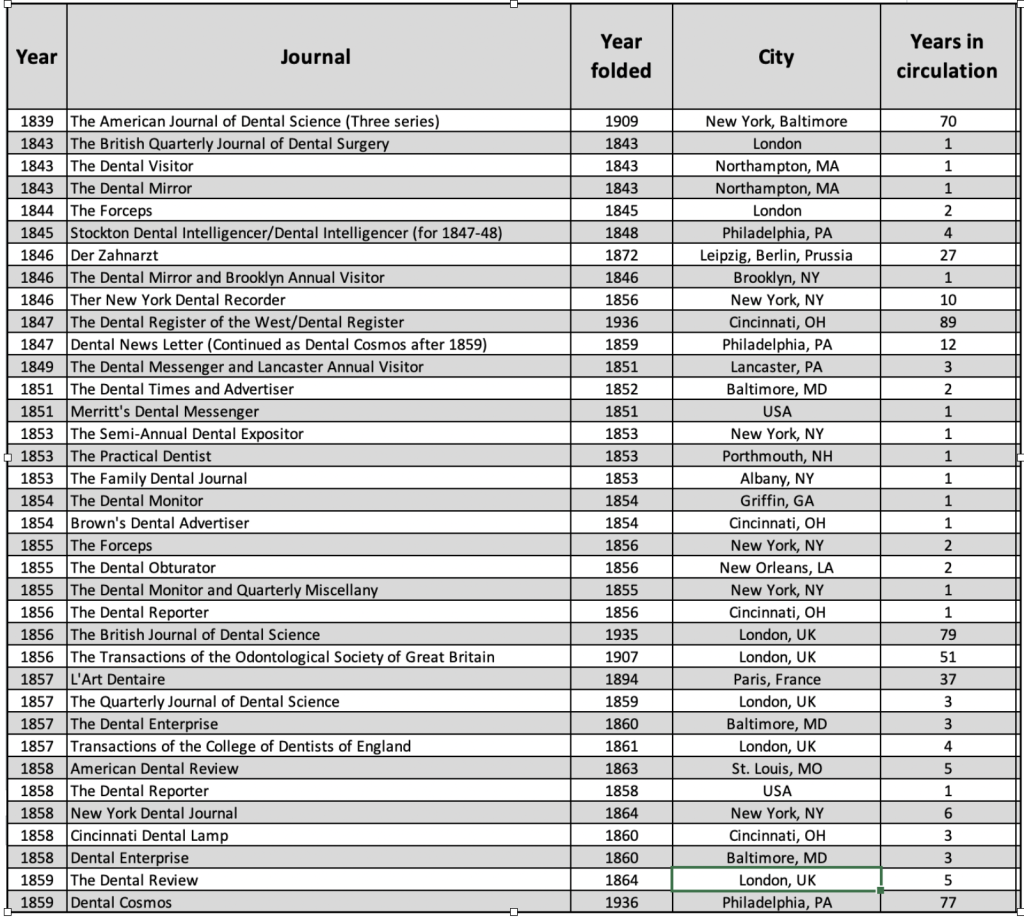
Table 1. List of dental journals published between 1839-1859.
In the US, many dental publications were acquired by dental trade companies and supply houses (Fig. 5) (12), causing concern over the potential conflict between unbiased scientific exchange and commercial interests. A notable example was “The Dental Cosmos,” established in 1859 as a continuation of the Dental News Letter. In 1861 it was entirely owned by Dr. Samuel Stockton White, founder of the S.S. White Company (1844), who hired business-oriented editors with marketing experience to ensure the journal’s success and profitability. “The Dental Cosmos” persisted until 1936 when it merged with the “Journal of the American Dental Association” (JADA).

Figure 5. Sample dental publications acquired by dental trade companies and supply houses in the second half of the 19th-century.

Table 2. Following the American initiatives, dental publications started to appear in most European countries.
Following the American initiatives, dental publications started to appear in most European countries (Table 2) (2), including England (1843), Prussia (Germany, 1846), France (1857), Austria (1861), Canada (1868), Italy (1872), Denmark (1873), Cuba (1880), Belgium (1884) and Russia (1885).
In 1843, James Robinson established The British Quarterly Journal of Dental Surgery in England. There was much anticipation of how the world across the Atlantic would react. To the delight of the editor, it was a triumphant reception. Eleazer Parmly, the American Journal of Dental Science editor, has written a partially reproduced letter (Fig. 6, 7) (13).
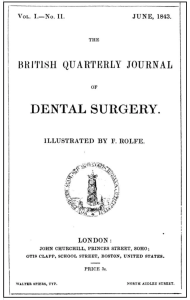
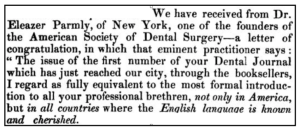
Figures 6 (above, top). The cover page of the first issue of the The British Quarterly Journal of Dental Surgery. Figure 7. Eleazer Parmly, the editor of The American Journal and Library of Dental Science welcome note from New York.
The first dental journal in England did not last beyond its initial year. However, between 1843 and 1873, at least ten other journals emerged, reflecting a burgeoning interest in dental literature. A standout among these was “The British Journal of Dental Science,” established in 1856, which would go on to have a more enduring impact. It became the official publication of the Odontological Society of Great Britain from 1863 to 1907, and starting in 1903, it was renamed the “British Dental Journal.” (14)
Other journals emerged rapidly, with “Transactions of the Odontological Society of Great Britain” in 1856, “The Quarterly Journal of Dental Science” in 1857, and “The Dental Review” in 1858. All three journals were based in London. In 1872, “The Monthly Review” was established, with James Oakley Coles of the National Dental Hospital serving as its editor for the first five years. In 1881, it was renamed “The Monthly Review of Dental Surgery” and became the official publication of the British Dental Association, which was founded in 1880. (14)
The trend of dental journals spread across Europe, with French dental journals like “Le Progress Dentaire,” founded in Paris in 1874, followed by “l’Odontologie” and “Revue Odontologique,” both in 1880 and “Le Monde Dentaire” in 1885. Around the same time, German-language journals appeared, mainly in Berlin, such as “Der Zahnarzt” in 1856 (which discontinued after one year), “Zahnartzlicher Almanach” in 1876, “Correspondenz-Blatt fur Zahnarzte” in 1871, “Die Zahntechnische Reform” in 1881, and “Deutsche Monatsschrift fur Zahnheilkunde” in 1883, which continued until 1933, when many publications were curtailed by Nazi laws. (15)
A pivotal moment in dental publishing history came in 1919 when William J. Gies established the “Journal of Dental Research” (JDR) and the International Association for Dental Research. Gies’s inaugural editorial emphasized the altruistic and progressive spirit behind the journal’s creation, asserting that it was “conceived in scientific altruism, born of the spirit of dental progress, and nurtured on the ideals of public service.” The JDR, with an impact factor of 7.6 over the last five years, has published over 14,000 articles in its 105-year history. (Fig. 8) (16).

Figure 8. Editorial notes of William J Gies in the Introduction to the first issue of the Journal of Dental Research, 1919. (16)
The 1990s saw the rise of the Internet and digital journal access, transforming the publication landscape. This shift allowed virtually any publication to be accessible online with the right subscription, reducing the influence that dental supply houses once had in dental publishing. However, the consolidation of publishing houses into a handful of major entities led to the creation of open-access journals. Today, many dental journals are open-access, although the business model has shifted, with publishers charging authors fees for publishing, while peer reviews are often provided by experts for free. These shifts have prompted many professionals to create open-source papers, ensuring free distribution of academic work and emphasizing the changing dynamics within the publishing industry.
Considering the remarkable growth in dental publications over the last 185 years, scientific journals have evolved from humble beginnings into a 19-billion-dollar industry. Presently, approximately 46,000 scientific journals are published each year, with the top 100 publishers producing over 28,000 of those journals (17). The field of dentistry accounts for over 320 journals among this vast pool of scientific publications.
Academic publishing plays a significant role in this expansive industry. Of the 100 publishers, the top five collectively account for nearly half of the revenue. This concentration of sales among a small number of top-tier publishers reflects the substantial influence they have in the scientific publishing landscape, driving the continued growth and distribution of scientific research, including in the field of dentistry. These statistics underscore the extensive reach and economic impact of scientific journals in the modern era, emphasizing the industry’s ongoing importance to both researchers and the broader academic community.
1. Atkinson; 2. The Phil Trans; 3. Journal des Scavant; 4. Fife et al.; 5.McCutcheon; 6. The Philosophical Soc; 7. Edinb Med J; 8. Manget; 9. Chorin; 10.Anonymous (a); 11. Taft; Coles; 12. ACD; 13. BQJDS; 14. Gelbier; 15. Bergmann et al., 2021; 16. Gies, 1919, p.3; 17. Nishikawa-Pacher, 2022.
References on Professional Dental Publications
American College of Dentists (ACD) (1932). The status of dental journalism in the United States. Report of the Commission on Journalism of the American College of Dentists, 1928-1931. American College of Dentists. Commission on Journalism. New York. p.12
Anonymous (a) (1790). Medicinisch-chirurgische Zeitung. Vol 1(3): 33-48; vol 1(4):49-64).
Atkinson, Dwight (1996). The Philosophical Transactions of the Royal Society of London, 1675–1975: A sociohistorical discourse analysis. Cambridge University Press (online). Language in Society, Volume 25, Issue 3, September 1996, pp. 333-371. DOI: https://doi.org/10.1017/S0047404500019205
Audibran, Joseph (1847). Fondation de la société de chirurgie dentaire de Paris : Brochure d’un intérêt général, p.141.
Bergmann C, Westemeier J, Gross D. (2021). The Editors of Scientific Journals in Dentistry in Nazi Germany and after 1945: A Sociodemographic Study. Journal of the History of Medicine and Allied Sciences, Vol. 77, No. 1, pp. 48–80 doi: 10.1093/jhmas/jrab045
Booth CC. (1982). Medical communication: the old and new. The development of medical journals in Britain. Br Med J (Clin Res Ed). 285(6335):105–8.https://doi.org/10.1136/bmj.285.6335.105.
Botot, E.F. Julien (1770). Observations, sur la suppuration des gencive. Journal de Medicine, Chirurgie, Pharmacie. Vol 32, January, p 356-372. https://archive.org/details/s3id13654830.
The British Quarterly Journal of Dental Surgery (BQJDS) (1843). London: John Churchill. Vol 1, Issue II.
Chorin M. (1791). Sur l’Operation d’un Bec-de-Lievre double, avec fente a la voute du palais. Journal de Chirurgie, 1791. Vol 1., p. 97-106. https://www.google.com/books/edition/Journal_de_chirurgie/lltT7FS2iokC?hl=en&gbpv=1&bsq=dent
Coles, James Oakley (1883). A list of works on dentistry published between … 1536 and 1882. United Kingdom: (n.p.).
Fyfe A, Moxham N, McDougall-Waters J, Mørk Røstvik C. (2022). A History of Scientific Journals, Publishing at the Royal Society, 1665–2015. UCL Press, London. www.uclpress.co.uk
Gelbier S (2005). 125 Years of developments in dentistry, 1880-2005. Part 1: British Dental and other journals. Brit Dent. Journal 199(6):389-395.
Ghasemi A, Mirmiran P, Kashfi K, and Bahadoran Z. (2023). Scientific Publishing in Biomedicine: A Brief History of Scientific Journals. Int J Endocrinol Metab. 21(1):e131812. https://doi.org/10.5812/ijem-131812.
Gies, WJ. (1919). The Journal of Dental Research (Editorial) – J Dent Res.1:1-7.
Journal des Sçavans (1665). https://gallica.bnf.fr/ark:/12148/bpt6k56523g/f5.image.
Manget (1774). A locked jaw from a nerve being pricked by a false tooth. The Medical and Philosophical Commentaries of the Society of Physicians in Edinburgh. United Kingdom: Eds. J. Murray, Kincaid and Creech, and W. Drummond, Edinburgh; T. Ewing, Dublin. p.316-317.
McCutcheon, Roger Philip (1924).The “Journal Des Sçavans” and the “Philosophical Transactions of the Royal Society” Studies in Philology, 21(4):626-628. https://www.jstor.org/stable/4171899
Nishikawa-Pacher, Andreas (2022). Who are the 100 largest scientific publishers by journal count? A web scraping approach. Journal of Documentation 78(7):450-463. Emerald Publishing Limited, 0022-0418 DOI: 10.1108/JD-04-2022-0083
Philosophical Transactions (1665). Introduction. Vol 1. p.1. https://royalsocietypublishing.org/toc/rstl/1665/1/1 https://doi.org/10.1098/rstl.1665.0001 https://royalsocietypublishing.org/doi/epdf/10.1098/rstl.1665.0001
Taft J. (1886). Index of the Periodical Literature of Dental Science and Art. Philadelphia: P Blakiston, Son & Co.,
The Philosophical Society of Edinburgh (1733). The Preface, IN: Medical essays and observations. Volume 1, 1733. p.VI. Revised and Published by A Society in Edinburgh. Printed by T and W Ruddimans, Edinburgh. https://archive.org/details/s5id13407060/page/n11/mode/2up.
